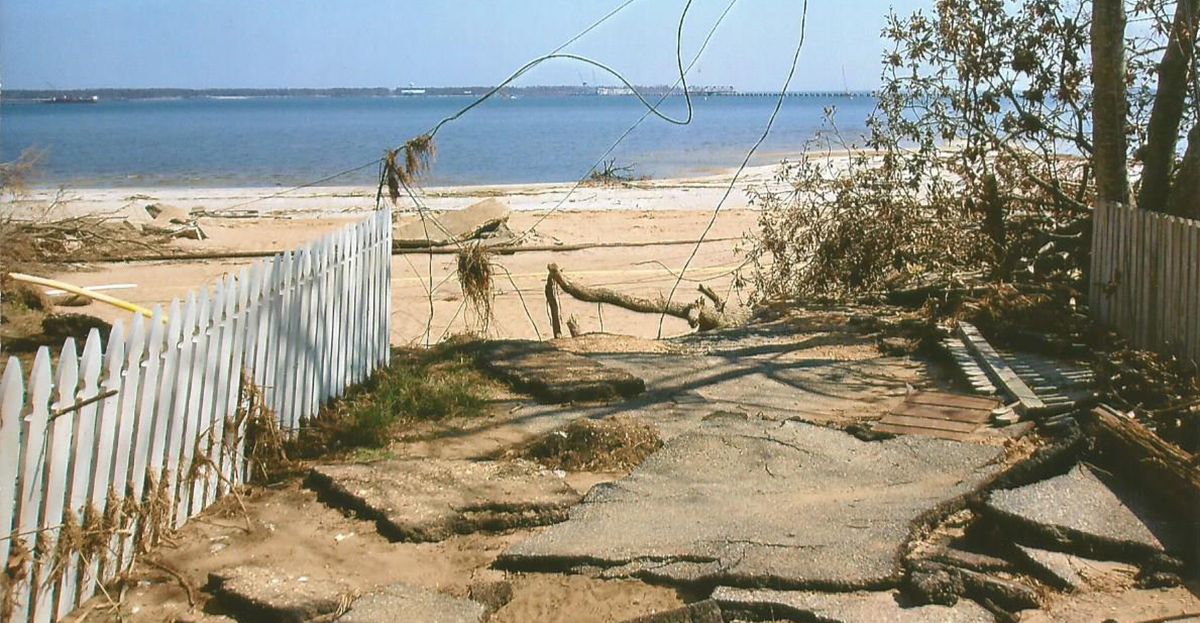Mississippi’s Gulf Coast was ground zero for the worst impacts of the historic 2005 storm.
To leave or not to leave — in hurricane season, that is often the most consequential question anyone can answer.
In the best-case scenario, staying put during a hurricane can give you a headstart on cleanup and maybe a chance at saving your home from the wind, rain and surge of water. At worst, there’s nothing to clean up and you’re no longer able to do it, anyway.
“It’s a very scary sound in a hurricane, especially when it’s dark, because the wind howls and things are flying and hitting the house and you can see things flying through the air and the roof feels like it’s going to come off and the windows rattle,” says Shannon Arzola, a Gulfport resident who survived Hurricane Katrina’s wrath on Aug. 29, 2005. “Everything you can think of is what it is.”
But leaving often isn’t attractive, either. Evacuees take their anxieties with them as they spend the hours and days wondering if they’ll have a home when they return, or if looters will have picked through their personal belongings and stolen cherished memories. After particularly devastating storms like Katrina, which made its final landfall on the Mississippi-Louisiana border 20 years ago this week, just getting back can take days.
“The unspoken rule is if it’s a category three storm or less, you’re not really going to leave because you don’t want looters to take what you have left before you can get back,” she says.
Arzola has plenty of experience with that call. As a child, she rode out the infamous Hurricane Camille in 1969 at a home a few miles north of her family’s Second Street home. If police officers hadn’t made them evacuate, her story could have been far different. The same would be true if she hadn’t left her home in Bay St. Louis ahead of Katrina. Fortunately, late on Aug. 28, Arzola’s brother finally convinced her to join him in Gulfport to ride out the storm.
“Katrina changed everything for everyone on the Mississippi Coast in just 12 hours. Nothing was normal again for several years. Katrina took so much from so many that it is impossible to describe. No more house for me, and no house for anyone in my family. No photos, no clothes, no dishes, no baby books, no furniture, no place to live. If you had money it didn’t matter because there was nothing to buy and no where to buy it.”
Shannon Arzola
Around 10:30 p.m., as squalls pushed ashore, she grabbed her toothbrush, contact case and an extra shirt, loaded her dog into the car, and drove east. “I did all the things that you normally do,” she says. “I washed all the clothes and had batteries and candles, all the hurricane supplies, and I left them there and locked the door, not realizing they wouldn’t be there when I got back.”
Located three miles inland, her brother’s neighborhood had never flooded before. But at first light they noticed water encroaching into the backyard from Bernard Bayou, an offshoot of Back Bay that courses nearby. Then it entered the home. “The water just started coming, gradually moving towards the house, and then it just seemed like no time until it was up to my chin.”
As they floated in the house, heavy appliances and furniture came unmoored and bobbed in the murky water, now mixed with gasoline purchased for a generator they wouldn’t get to use. And then, through the spaces in the plywood screwed into the window frames to protect against flying debris, they noticed the house across the street was engulfed in flames.
“We were terrified that if we didn’t get out of the house quickly enough that one of those balls of fire was going to hit the house, and then that would catch on fire and then we’d all be stuck inside,” Arzola says.
They were able to bang their way through a boarded window and jump, but they landed in much deeper water. Taking refuge on the top of a truck cab, along with the dogs, they dodged projectiles and strained to hold on during the storm’s worst wind gusts for the next few hours. A refrigerator floated out of the house past them, followed by a birthday cake intended for her niece, who had safely evacuated to Jackson.
What awaited Arzola after the winds finally shifted north and the waters receded has stayed with her ever since. Now storm refugees, they made their way down Hewes Avenue to the beach. As she gazed from east to west along U.S. Hwy. 90, the scene looked “like somebody had taken a vacuum cleaner and sucked away all the homes.” The empty slabs held no mystery, though; the 12-foot-high wall of debris pushed against the railroad tracks some 400 yards from the shoreline told the rest of the story.
Farther inland but closer to the storm’s center, sixth-grader Sereena Henderson sheltered in her family’s two-bedroom home in DeLisle, just northeast of Bay of St. Louis, along with more than a dozen family members who came up from the lower elevations of Pass Christian.
“When we knew about Katrina, it wasn’t discussed like if we would evacuate, because we would just always stay at the house,” says Henderson, now of Austin, Texas. “It was typical for our family members to come and stay with us.”
The instinct to seek higher ground and the security of family was on display in other ways, as well. While her parents were boarding up the windows ahead of the storm, Henderson and her younger sister distracted themselves by caring for a stray cat and the newborn kittens she carried to the house one by one. They all rode out the violent winds of Katrina’s eastern eye wall together.
“It was so loud and our house was shaking for so long,” Henderson says. “I don’t even really remember what the outside looked like. I just remember the feeling of it and the sound, and I really felt like our house was going to blow away. My family and I, to this day we say that if all those people weren’t in our house, it would have flown away.”
At the height of the storm, her father and uncles had to venture into the wind and rain to strap and stake the carport columns into the ground to help keep the intense winds from tearing off the roof. After the storm passed, she and her family reemerged into a changed landscape strewn with debris. All the pink insulation that had been sucked from the crawlspace under the house now hung from the spaces in their chain-link fence. As Henderson picked out the soggy clumps of fiberglass, all she could think about was returning to school, which had begun a week earlier.
“I remember asking, ‘When can I go back to school? I really want to go back to school. I want to see my friends,’” she says. “And I remember someone saying, ‘Sereena, your school is gone.’ And I was like, ‘What do you mean it’s gone?’ And they were just like, ‘Your school is gone. I’m sure a lot of your friends, their homes are gone.’ It was unbelievable, you know, when you first heard that.”
Arzola’s home was among the more than 60,000 dwellings destroyed or rendered uninhabitable by Katrina. A storm surge exceeding 30 feet in height went completely over the top of her one-story ranch, which sat 22 feet above sea level. But she wouldn’t know this for several days. First, she had to locate her mother, who had advanced COPD and was evacuated from a hospital to a nursing home before the storm hit. It took her and her brother a day and a half, amid trying to stay alive, to reach her and get her back on an oxygen tank.
“By the time we found her, all the employees had abandoned the nursing home and left these poor people to fend for themselves, and some of them were not living any longer,” she says. They busted into her apartment, which had also been underwater, grabbed an oxygen tank and found a place for her to stay that hadn’t incurred much damage.
“It was very bleak for the first four or five days, because no one seemed to come from anywhere,” she says. “That’s when people just started helping each other with whatever. You realize that nobody was going to make it unless you all held each other. So, that’s just how things went.”
The disarray of the aftermath lingered in the days, weeks and months that followed. No one in Arzola’s family had a home anymore. She was robbed multiple times and slept wherever she could until finding an apartment that offered shelter, but not much else. Eventually, the rebuilding began — but the number of vacant lots from Waveland to Biloxi and points eastward are reminders that it’s not always easy to get back on your feet.
“To this day, if you just drive along Highway 90, you can see empty lots where people never built back,” Henderson says. “That is a sad reminder of how Katrina pushed people out and a lot of people just couldn’t build back something that they once had. And that’s both literally and figuratively.”
The decision to leave home, before or after the storm, became the conundrum for hundreds of thousands of Coastians. But in hindsight, if armed with foreknowledge of exactly what Katrina was bringing, Arzola believes many would have chosen to leave.
“I guarantee you more people would have made arrangements to be somewhere else or tried if we had known exactly how tall the water pushing ahead of it was,” she says. “But we just didn’t know.”


